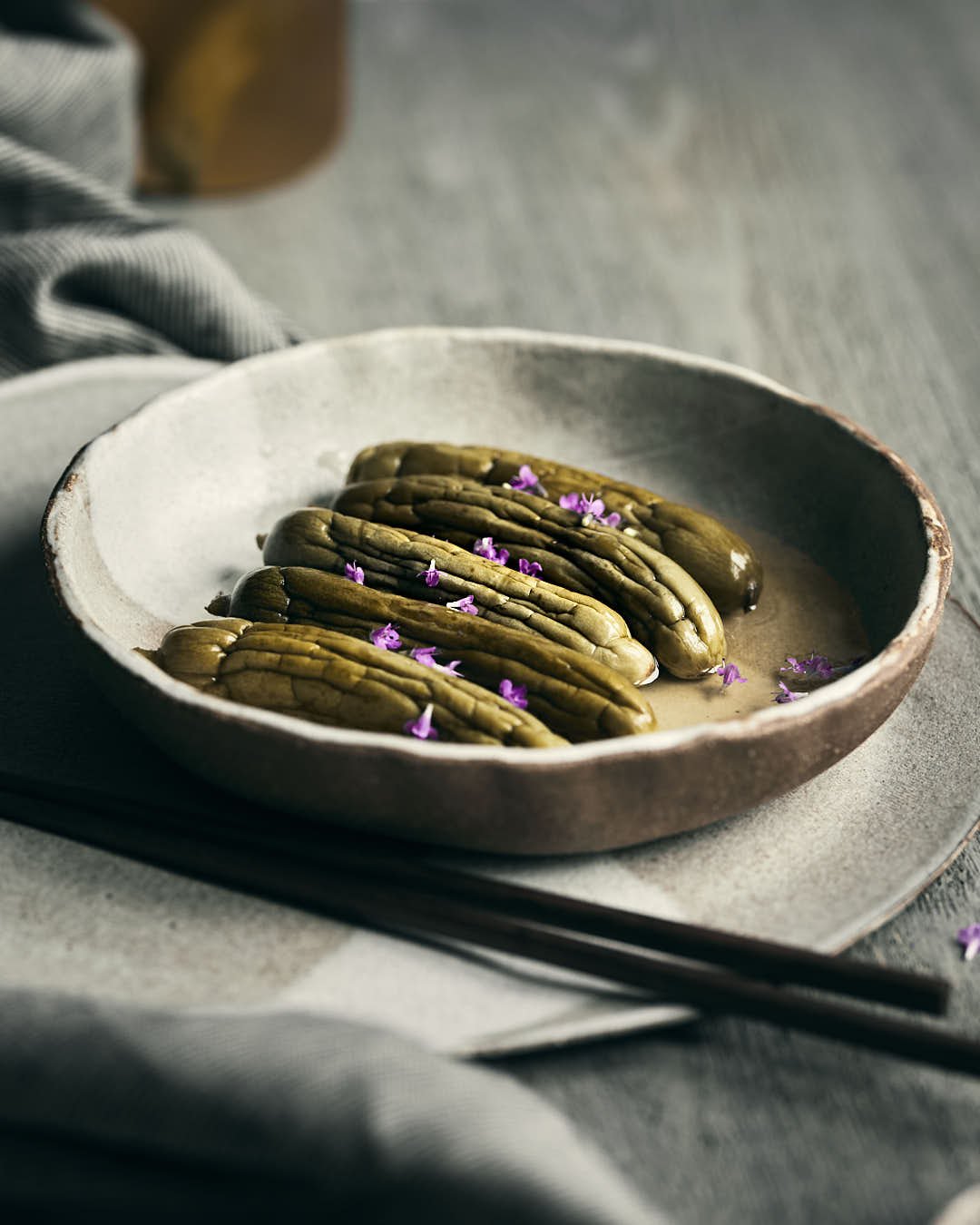Celery Kimchi
Born out of necessity as I suffer from a Kimchi addiction. At times when no Chinese Leaf is available, I used to get deranged in my withdrawal symptoms. So, upon receiving a job lot of celery in my veg box, I fermented it in the same way as I would Kimchi and a Star Was Born.
This is now my go to above and beyond conventional Kimchi.
Make it and there is no turning back
Ingredients:
2 Bunches Celery, finely chopped
20g Salt
1 Bunch Spring Onions, finely chopped
1 thumb Fresh Ginger, finely sliced
200g Carrot, cut into matchsticks
4 Cloves Garlic
1 Pear, roughly chopped
4 tbsp ochugaru (Korean Pepper Flakes)
100ml Fish Sauce (substitute Miso for Vegan)
1 tbsp Demerara Sugar
1 tbsp Glutenous Rice Flour
Method:
1. Before you start it is important to recognise that no metal implements should be used in this process.
2. Add the salt to the celery in a large non-reactive bowl. Stir with your hands and set aside for 2 hours.
3. Gently rinse the celery and pop back into the bowl along with the spring onions and carrot.
4. In a blender, add the garlic, pear, gochugaru, fish sauce, sugar and rice flour, pulse until you get a thick paste.
5. Massage the paste into the vegetables really well, squeezing to release some juice.
6. Pack into sterilised kilner jars pushing down each layer so it is tightly compacted.
7. Once done, the top should be submerged in kimchi juice, if not, fill a bag with water and weigh down the top (or use a kimchi weight)
8. Allow to ferment with the lid attached for 3-4 days. It is imperative that you release the gas a couple of times each day by opening the lid.
9. Once you see bubbles, you can pop it in the fridge or continue the ferment for a few more days if you like a sourer taste.
10. Once in the fridge you can seal the lid without the need to release any gas as the fermentation rate is slowed.
FERMENTATION GUIDES KOMBUCHA
Essentially, Kombucha is fermented iced tea that makes a fantastic replacement for fizzy/ alcoholic drinks. You can drink it as it is or flavour it with any fruit/ vegetable scraps you have lying around and, once you get around the somewhat ‘ugly’ nature of the ferment, it really is quite phenomenal to watch.
After your initial outlay for the SCOBY, its cheap and so much more economical than store bought Kombucha (I once paid £7 for a 350ml bottle!!).
Similar to Apple Cider Vinegar, Kombucha is made using a ‘mother’ or SCOBY. This stands for Symbiotic Culture Of Bacteria & Yeast. Akin to a disfigured stingray/jellyfish, it’snot the most attractive thing, but it will give you the most delicious drink so nurture it!
Once you get started, your SCOBY will grow prolifically, creating a new ‘baby’ each time a new batch is brewed. Hurrah! This means you can share round your fermentation love with all of your friends!
To begin, you will need to get hold of a SCOBY. If you are lucky enough to know someone that brews Kombucha, then go right ahead, just ask for about 500ml of their Kombucha with it so you can kick start your own batch. Otherwise, I would recommend either buying on Amazon (which is what I did) or there are plenty of forums where people are all too willing to offload their SCOBY babies.
The concept is simple. You are using your SCOBY to turn the sugar in sweetened tea into an effervescent probiotic drink. The tea you start off with will affect the ultimate flavour and colour of your kombucha. You can use Black, Green or White Tea (I favour Japanese Green Tea, but be warned, this will cause a green ‘pond scum’ on your SCOBY so don’t be alarmed). You will need to begin with a Sterile 5 litre fermentation jar. This can be anything, even a bucket but you CANNOT USE ANYTHING METAL near a SCOBY. This goes for all your equipment too. So, you will also need: a plastic spoon, sieve, glass bottle and some muslin and string.
1. Measure 1 litre boiling water into a heatproof container. Stir in 260-300g sugar and 4tbsp tea leaves (or use about 10 tea bags). Allow to brew to 20 minutes (no more or your mix will be too bitter).
2. Add 3 litres of cold filtered water into your fermentation jar and, using your plastic sieve, strain in the sweet tea.
3. Add your SCOBY and its liquid to the jar, allowing it to float on the top. It might sink just a little but this is fine, it will stay where it is happy. Cover your jar with muslin to keep out any dust and secure with string or an elastic band.
4. Place somewhere warm, but not in direct sunlight and……leave it alone! Yep, for at least 6 days just forget about it. All different things will affect your fermentation rate and it really is all down to the individual mix and your taste.
5. After 6 days, taste the liquid. It should have balanced sweet and sourness. Continue checking every 3 days. I prefer mine slightly more sour than sweet but it’s entirely up to you. (at this point you can leave your kombucha to go ‘over’ for 4-8 weeks and you will get a beautiful Kombucha Vinegar for Salad dressings etc).
6. When it is to your taste, strain it through a muslin and plastic sieve into sterilised bottles and store in the fridge. The SCOBY should be kept with 500ml of the liquid and either used to start your second batch or stored in a plastic Tupperware in the fridge. It will keep like this for several months.
7. If, like me, you prefer your Kombucha with a touch of fizz, you’ll need to kick start a secondary fermentation. It is at this point that you can also introduce flavour into your mix.
8. Once you’ve bottled the mix, you’ll need to add 1 tbsp of sugar per litre to kick start the secondary fermentation. At this point you can also add some fruit or vegetable scraps such as ginger/orange peel/apple etc. I prefer to add flavour to each individual glass so I can change it up. For this I recommend homemade fruit, spice or flower syrups. Aim to add about 50g flavourings per litre.
9. Add tight lids to the bottles and leave them at room temperature. Every day you will need to ‘burp’ the bottles by briefly removing the lid to release the gas. Taste each day for up to 6 days until the carbonation is to your liking.
10. Once ready, refrigerate and drink within a month.
It really is that simple. Leave it alone and it will do all the hard work for you! And the great thing is, if you want to take a break your SCOBY will be super happy just chilling out in the fridge, the perfect low maintenance pet!
FERMENTATION GUIDES FERMENTED CUCUMBERS
‘Fermentation may have been a better invention than fire’ David Wallace
Fermentation harnesses the power of Nature to preserve beyond the boundaries of seasonality. Fresh homegrown summer cucumbers take on a piquancy that is suggestive of their tine in the sun, well into the months of the hunger gap where little grows aside from root vegetables.
These are the perfect addition to roast potatoes, noodles, rice and salads, anything goes.
Ingredients:
500g Mini Cucumbers, whole
100ml Elderflower Vinegar
70g Golden Caster Sugar
10g Flaky Sea Salt
1tsp Thyme Leaves
60ml Shaoxing Wine
Method:
1. It couldn’t be simpler. Arrange the cucumbers in a single layer, snugly nestled next to each other in a shallow dish.
2. Mix the remaining ingredients together in a bowl and pour over. Pop a plate over the top and sit somewhere dark and relatively cool but room temperature for 3 days. Each day, give the dish a little shake to ensure the cucumbers stay wet.
3. As they ferment, they will become wrinkled and the liquid will increase, this is normal. Transfer the cucumbers and their fermentation liquid to a sterile kilner jar and seal the lid.
4. Pop this in the fridge and allow to develop for a week. Your cucumbers are now ready! Discard the brine after a week and keep the remaining cucumbers in an airtight box for a month, but they never last that long!






